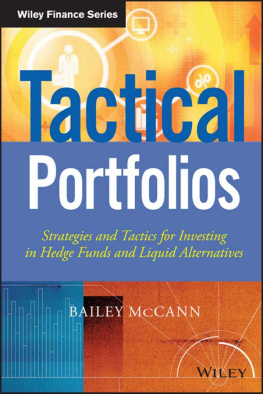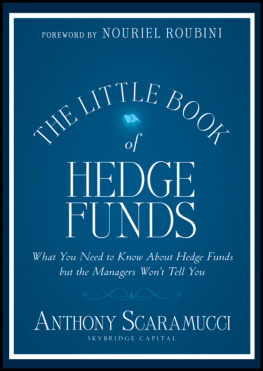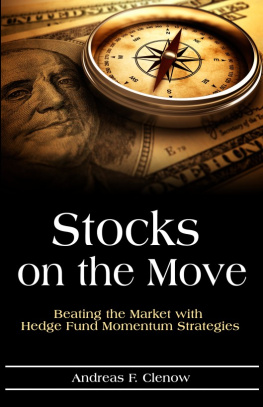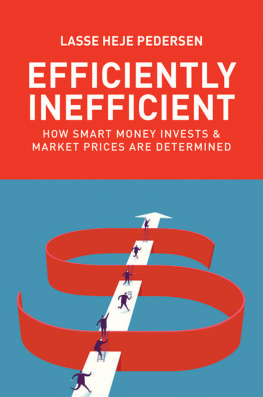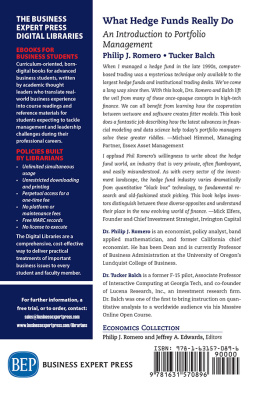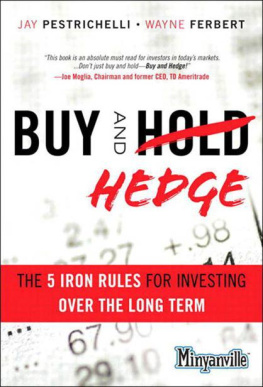
Founded in 1807, John Wiley & Sons is the oldest independent publishing company in the United States. With offices in North America, Europe, Australia, and Asia, Wiley is globally committed to developing and marketing print and electronic products and services for our customers professional and personal knowledge and understanding.
The Wiley Finance series contains books written specifically for finance and investment professionals as well as sophisticated individual investors and their financial advisors. Book topics range from portfolio management to e-commerce, risk management, financial engineering, valuation, and financial instrument analysis, as well as much more.
For a list of available titles, visit our web site at www.WileyFinance.com.
Cover image: top: Fanatic Studio / Jupiter Images
bottom: Photodisc / Jupiter Images
Cover design: Wiley
Copyright 2014 by Bailey McCann. All rights reserved.
Published by John Wiley & Sons, Inc., Hoboken, New Jersey.
Published simultaneously in Canada.
No part of this publication may be reproduced, stored in a retrieval system, or transmitted in any form or by any means, electronic, mechanical, photocopying, recording, scanning, or otherwise, except as permitted under Section 107 or 108 of the 1976 United States Copyright Act, without either the prior written permission of the Publisher, or authorization through payment of the appropriate per-copy fee to the Copyright Clearance Center, Inc., 222 Rosewood Drive, Danvers, MA 01923, (978) 750-8400, fax (978) 646-8600, or on the Web at www.copyright.com. Requests to the Publisher for permission should be addressed to the Permissions Department, John Wiley & Sons, Inc., 111 River Street, Hoboken, NJ 07030, (201) 748-6011, fax (201) 748-6008, or online at http://www.wiley.com/go/permissions.
Limit of Liability/Disclaimer of Warranty: While the publisher and author have used their best efforts in preparing this book, they make no representations or warranties with respect to the accuracy or completeness of the contents of this book and specifically disclaim any implied warranties of merchantability or fitness for a particular purpose. No warranty may be created or extended by sales representatives or written sales materials. The advice and strategies contained herein may not be suitable for your situation. You should consult with a professional where appropriate. Neither the publisher nor author shall be liable for any loss of profit or any other commercial damages, including but not limited to special, incidental, consequential, or other damages.
For general information on our other products and services or for technical support, please contact our Customer Care Department within the United States at (800) 762-2974, outside the United States at (317) 572-3993, or fax (317) 572-4002.
Wiley publishes in a variety of print and electronic formats and by print-on-demand. Some material included with standard print versions of this book may not be included in e-books or in print-on-demand. If this book refers to media such as a CD or DVD that is not included in the version you purchased, you may download this material at http://booksupport.wiley.com. For more information about Wiley products, visit www.wiley.com.
Library of Congress Cataloging-in-Publication Data:
ISBN 978-1-118-73162-8 (Hardcover)
ISBN 978-1-118-73158-1 (ePDF)
ISBN 978-1-118-73163-5 (ePub)
Introduction
In just one decade, stocks have halved two times. After reaching a new high in the first quarter of 2000, the MSCI World stock index found a bottom in September 2002 following the dot.com crisis. The index, which captures large and mid-cap stocks, lost over 48 percent while hedge funds (as measured by the HFR Weighted Composite Index) were up net of fees 2.1 percent. When the global financial crisis took stocks down over 50 percent from their tops in early 2007 through October 2009, hedge fund investors were reaping over 6 percent during the same time.
Helped by floods of quantitative easing, many global stocks have reached new highs in 2013.
You would think that investors would now hedge their bets and move to hedge funds to protect their assets and establish a meaningful diversification. The smart money has done this, maintaining a significant allocation to hedge funds.
INVESTORS EXIT HEDGE FUNDS AT FASTEST RATE IN FOUR YEARS
Investors exit hedge funds at fastest rate in four years, says a Reuters headline on January 13th, 2014. The article refers to the SS&C GlobeOp Capital Movement Index which calculates monthly hedge fund subscriptions (in-flows) less redemptions (out-flows). With 3.56 percent, December 2013 showed the biggest drop since September 2009. The article continues that while the end of the year period usually sees a pick-up in redemptions as investors look to move money around their portfolio ahead of the New Year, Decembers reading is notably high. In the same month last year the index measured minus 2.61 percent.
For 2013, SS&C GlobeOps Hedge Fund Performance Index was up 12.32 percent, which is about half of the return of the MSCI World Index. So, hedge funds have performed well, but maybe not good enough?
Today (January 14th, 2014), as I write this introduction, another interesting story: Global stocks fall on concerns about earningsis angst coming back to the markets? Right now, we dont know what will happen and may soon enter an environment where investors wish they had invested more in hedge funds and absolute return strategies than in long-only equity.
Alexander Ineichen, one of the most well-known researchers on hedge funds globally, offers the following advice: Equity investors have been dancing on thin ice and might continue to do so. Its difficult to say how long the ice holds. Im quite certain though, that at one stage a hedged approach will reveal itself as more intelligent than a long-only approach. Again. To stick with the metaphor: A long-only investment style is like dancing on thin ice, while a long/short investment style is like dancing on thin ice wearing swimmies: it might look odd at times but its safer.
LEARNING FROM YALE: 51 PERCENT ALLOCATION TO ALTERNATIVE INVESTMENTS
Yales $20bn endowment has included alternative investment strategies for over 20 years now. The so-called endowment model aims to achieve superior returns by shifting a significant portion of investments away from traditional stocks and bonds into carefully selected alternative investments like private equity, hedge funds, real estate, and others.
While the global financial crisis also managed to drawdown the value of Yales endowment 24.6 percent in the fiscal year ending June 2009, the endowment model is still regarded the most viable proposition for long-term investors. How does Yale invest? For 2014, Yales investment targets include a massive 51 percent allocation to alternatives, while only 17 percent is reserved for international and domestic U.S. equities.
Yales investment team, made up of 26 experts, are of course, not the only institutional investors who look to create tactical portfolios using alternative investments for both return and diversification goals. Ninety-four percent of institutional investors surveyed by Russell Investments said they already allocate to some form of alternatives, on average 22 percent of total assets. This already represents a significant allocation, which over time will only continue to go up. In the last three years, alternative mandates accounted for over 40 percent of all institutional hiring activity made during this period.
HEDGE FUNDS, EMERGING MANAGERS, LIQUID INVESTMENTS, AND MANAGED FUTURES
Next page
